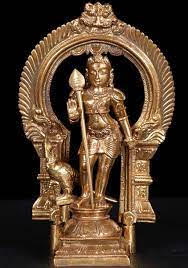Stone has been the primary medium for making representations of Hindu deities for devotion throughout much of Indian history.
One of the notable exceptions to this tendency may be seen in southern India, especially during the Chola empire (9th–14th centuries), when bronze was also a major media.
Lost wax casting was used to create the pictures, which allows for a lot of detail.
They were made of bronze with a high copper content, which oxidized to a greenish hue when the metal deteriorated.
Some of the pictures are just a few inches tall, but with amazing detail, while the biggest are over four feet tall and are still revered in temples today.
The same established principles of building (shilpa shastra) applied to these pictures as they did to stone sculptures.
Despite their rigid form, many of the bronze sculptures are great works of art with a presence not often seen in stone sculptures.
Although representations of all of the gods in the pantheon were created, the deity Shiva as Nataraja, or "Lord of the Dance," is one of the most well-known bronzes.
Discover more about Hindu Art, Architecture, and Iconography here.
You may also want to read more about Hinduism here.






